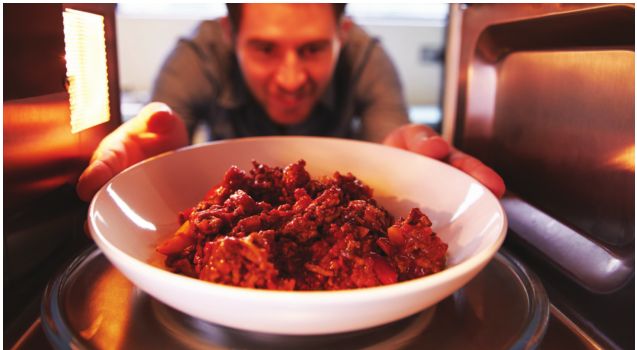
The microwave is our friend
The thought of microwave cooking apparently doesn’t jibe with the most peoples’ idea of delicious, healthful eating. When I took an informal poll of friends who do a lot of scratch cooking, most of them said they don’t regularly use their microwave, and when they do it's just to rewarm leftovers. I guess this shouldn’t come as a surprise, but it blows my mind all the same.
I love my microwave. It gets used morning and night in our house, despite the fact that the vast majority of the food we eat is fresh and homemade. I like to think of the microwave as a giant steamer rather than a little oven, and regularly use it to poach eggs and make cinnamon apples for breakfast, steam veggies for supper, and soften butter and melt chocolate when baking. A pastry chef I know even makes lemon curd in the microwave!
The microwave has had a bit of a PR problem over the years. A quick survey of vintage microwave cookbooks illustrates why: cover after cover features glossy photos of browned prime rib or a roast chicken and potatoes, in spite of the fact that microwaves are simply terrible at cooking large pieces of meat. Also problematic are rumors that microwaves deplete nutrients in food.
It helps to understand how this everyday appliance works. Microwave ovens convert electricity into microwaves. The microwaves heat food by twisting water molecules in the food back and forth, generating friction and therefore heat, essentially cooking food simultaneously both outside and in. That’s why microwave ovens cook more quickly than conventional ovens, which heat food via conduction from the outside. This is also why the microwaves are so poor at cooking dense foods like meat. The microwaves can only penetrate a few centimeters into the food before losing momentum, so the inside of the meat actually ends up being cooked by the conductive transfer of heat from the outside in. Translation: overcooked, rubbery meat.
Veggies and fruits, however, can be very nicely prepared in the microwave oven. Water is especially quick to absorb microwave energy, which is why a microwave oven works so well as a vegetable steamer. And because the molecules in the food are heated so rapidly, there is more nutrient retention than if the food were boiled, steamed over the stove, or baked. Vitamins easily leach out into cooking water, which can be mitigated when using a microwave since veggies can be steamed with little or no water.
I avoid using plastic in the microwave at all costs. Plastic containers absorb smells and I’m leery of chemicals leaching out from the plastic, no matter how microwave-safe the container is purported to be. Glass food storage containers are a worthy investment, and can often be found for bargain prices at garage sales and secondhand shops.
Did you know there are power settings on your microwave? On most microwaves the power setting can be adjusted from 10 to 100 percent. Most meat will often be slightly cooked around the edges if thawed on the preprogrammed “defrost” setting, but I’ve had great success thawing frozen ground meat or chicken thighs on 10 or 20 percent power for 15 minutes. The low power settings are also useful for softening butter for baking or gently softening ice cream. When I reheat something like a stew, I prefer to reheat it at 40 percent power for 10 minutes, rather than three or four minutes on full power.
It’s important to note that microwave ovens vary widely, and you’ll have to figure out the exact times and settings that work for your particular machine. I know that three cups of broccoli in a six-cup dish will steam in three minutes thirty seconds in my microwave, but it might be four minutes in another.
Eggs can be cooked surprisingly well in the microwave, either poached or scrambled. I love to have a poached egg on top of sautéed spinach for a light lunch. Crack an egg into a bowl and add a tablespoon of white or cider vinegar and about a cup of water. Cover with a plate and microwave at 50 percent power for about two minutes then simply lift out the egg with a slotted spoon. To make scrambled eggs, coat a bowl with softened butter or olive oil (this makes it easier to clean later), then beat some eggs into the bowl. Season, add cheese or cooked veggies/ meats as desired. Microwave at 50 percent power for one minute, then stir and continue microwaving at one-minute intervals, stirring each time. Eggs are usually done in about three minutes.
When I roast veggies on a sheet pan I will often lightly steam the carrots or potatoes in the microwave first before tossing them with oil and transferring to a roasting pan with raw broccoli or another quick-cooking veggie. After 10 or 15 minutes in the oven it’s all done at once and ready to serve. Likewise if I want baked potatoes but am short on time I will parcook russet or sweet potatoes in the microwave using the preprogrammed “potato” setting before transferring them to a 400-degree oven to finish cooking for a final 20 minutes.
Cinnamon apples are a wonderful breakfast treat for kids. Peel, cut and core an apple into wedges. Sprinkle with cinnamon and microwave in a covered bowl for a minute and a half to two minutes. Apples will be just soft and ready to eat. I often do this when baking recipes call for a small amount of applesauce. Just cut up an apple, microwave it, then mash it up to use in the recipe.